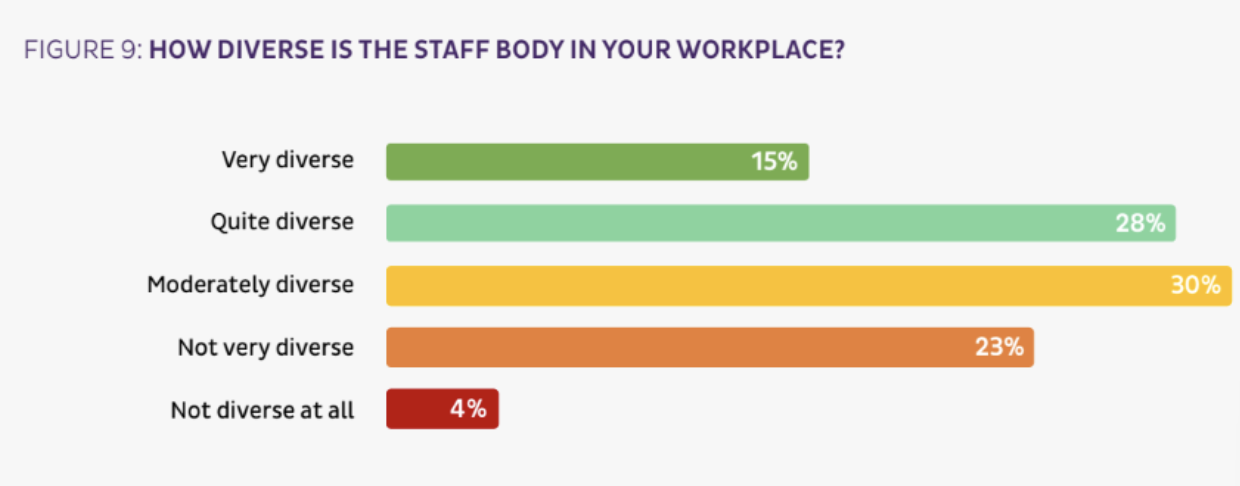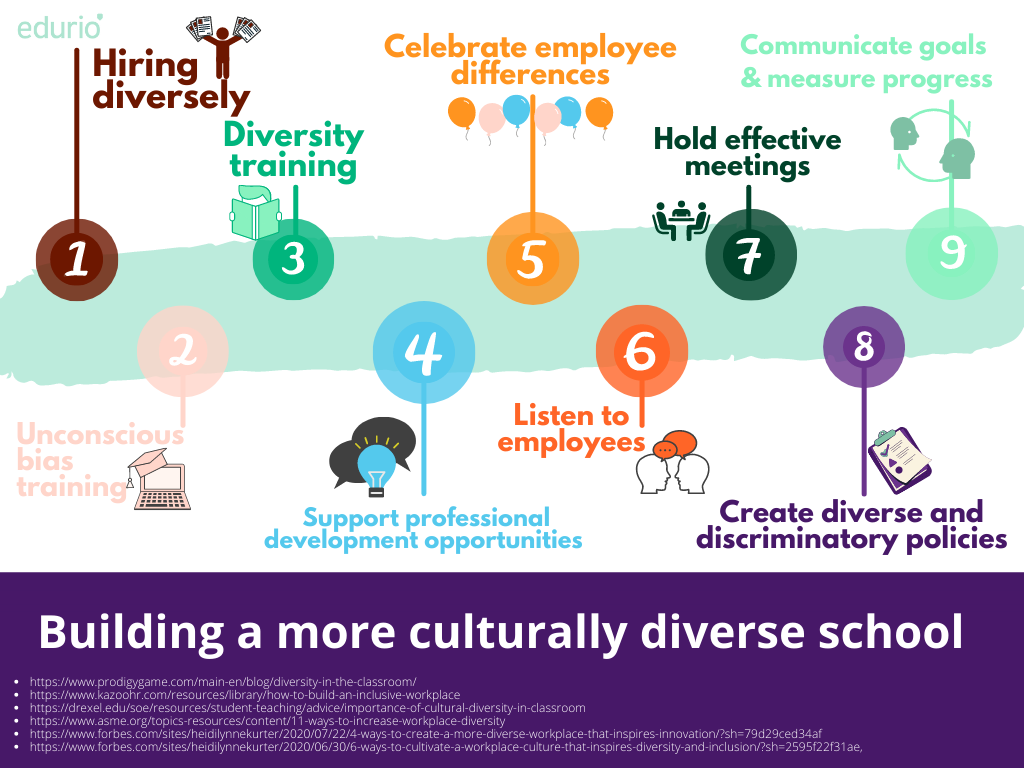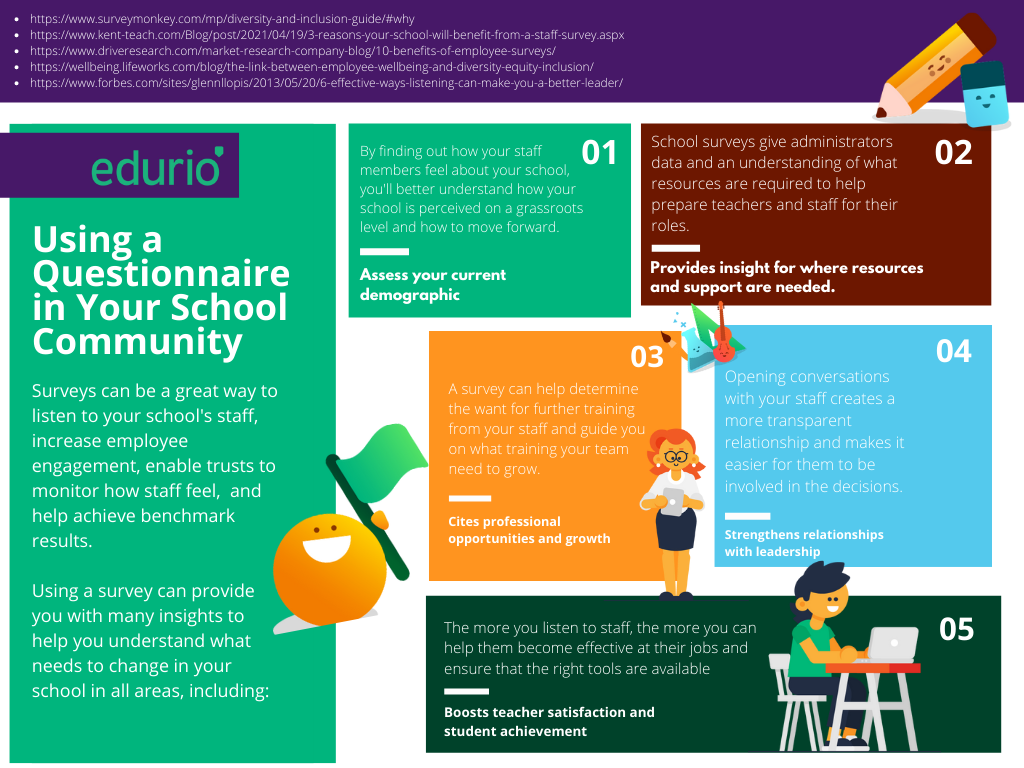It is often said "that it takes a village to raise a child." This phrase can be used to illustrate how a child's development and growth depends on more than just their parents/carers, it also includes family friends, neighbours and schools. Yet, a variety of people with different characteristics make up a village, and this can raise an interesting concept about the different types of people needed during a child's development.
You can meet people from different backgrounds in any community, with different physical abilities and qualities, appearances, life and work experiences, and other commitments. Diversity reflects this and can be found throughout England's schools, but unfortunately, it isn't always reflected in its staff members.
For instance, in our 2021 equality, diversity and inclusion (EDI) report, we found that less than half (43%) of staff felt their workplace was diverse, and fewer still (36%) felt that the diversity of the staff body reflects that of their students.


Each individual brings their own unique background to their workplace and experiences the workplace in their unique way. In this article, we'll be looking at how an equality, diversity and inclusion survey can help your trust and school become more aware of its makeup and subsequent needs, and share some findings from our 2021 equality, diversity and inclusion report.
Why Do We Need Diversity in Education?
What Has Edurio Learnt about England's School Environment
Are UK School Leaders Diverse?
How to Build More Equal, Diverse and Inclusive Culture in Schools
How to Use a Questionnaire in Your School Community
Edurio’s Equality, Diversity and Inclusion Survey
Why Do We Need Diversity in Education?
Education is a vital part of a society's growth and progress, so it makes sense that our schools should reflect the diversity of our communities. Our classrooms don't exist in a vacuum outside of our society. The learning experience our young people receive can help provide an understanding of 'the other', which can help tackle racial discord and even reduce bullying.
For example, studies show when lesson plans reflect the students and their varied backgrounds, they develop a deeper knowledge of a subject. This equips learners with a broader understanding and often leads to students working harder and achieving more.

Researchers at the University of California Los Angeles (UCLA) and the University of Groningen in the Netherlands found that when lesson plans reflect the students and their varied backgrounds, they enrich their overall learning, promoting creativity and higher achievements.
Photo by Rodolfo Quirós from Pexels
With this evidence to hand, it may make sense that we would want our children to see evidence of equality, diversity, and inclusion in their learning environment regularly. From the moment young people enter a school, its decoration, lessons, and even the school staff and leaders all provide an opportunity to promote a diverse environment. A diverse school can provide a richer, more profound education, a more balanced view of the content covered, improve staff mental health, wellbeing and satisfaction, and enhance creativity, leading to better decision making and problem-solving. Overall, by fully utilising the diversity of your society, the more resilient, both academically and emotionally, your school can be.
Of course, representing diversity isn't just a box-ticking exercise or a project to make you Of course, representing diversity isn't just a box-ticking exercise or a project to make you feel like you're doing something. While the 2010 Equality Act stands to protect those with protected characteristics from discrimination, " education remains one of the best tools we have to tackle inequality and discrimination." So, without introducing different cultures, races and gender early on in life or as a society, The Guardian warns that we "may risk a lack of intellectual growth" or, as the EU Business School puts it, we may "fail to combat prejudice."
What Has Edurio Learnt about England’s School Environment?
Here at Edurio, earlier in 2021, we collected the largest data set on EDI issues within schools to date to produce a national benchmark reflecting the opinions of over 16,500 staff members from 380 schools who took part between January-March 2021. A major focus of this analysis reflected how different staff groups (across a range of demographic and other characteristics) experience life in the school and trust structure.

This review allowed us to explore day to day workplace experiences, recruitment experiences and career development opportunities between different staff groups across the country. In addition to responding to general questions about workplace experience, respondents also described their identity and background based on protected characteristics such as age, disability, gender reassignment, marriage and civil partnership, pregnancy and maternity, race, religion and belief, gender and sexual orientation. Therefore, our data provided an overview of how those with different protected characteristics saw equality, diversity and inclusion across various elements of school life.
At the start of this article, we mentioned that many in the education industry report a gap in representation between diverse students compared to their leadership teams. In our EDI 2021 report, we also highlight this gap in representation between England's staff. Most staff we surveyed said that they "do not feel the diversity of their workforce reflects its student bodies' protected characteristics." With others even voicing why they think their leadership teams lack diversity, "The position of Deputy Head was recently advertised, and the person spec requires a first-class degree. I would be concerned that this could hinder the diversity of the applicants." Data such as this is vital to understand how our schools can become more diverse because it gives a voice to those experiencing school life day in and day out.
Are UK School Leaders Diverse?
Therefore, if advocating diversity creates a thriving community and the best start in life for our children, it makes sense that the makeup of our school staff should represent the variety of people it educates. TES reported that Forum Strategy mirrored this sentiment, asserting that school leadership teams should reflect the diversity of the pupils they serve.
However, as it stands, UK schools often don't reflect this. Our 2021 EDI report found that less than half (43%) of teachers think their workplace is diverse, and only 28% think their leadership is.
Not only this, but a report from UCL Institute of Education (IOE) found that 46% of all schools in England have no Black, Asian and minority ethnic (BAME) teachers, and even in ethnically diverse schools, BAME teachers are underrepresented in senior leadership teams. So, unfortunately, while our schools recognise that equality, diversity and inclusion are helpful for our education sector, we do not see this in reality.
How to Build More Equal, Diverse and Inclusive Cultures in Schools
So, if you recognise that your school lacks diversity, you may want to consider creating an So, if you recognise that your school lacks diversity, you may want to consider creating an action plan to address this. As this is a significant undertaking, we’ve compiled a few steps school trusts can take towards this, curated from the American Society of Mechanical Engineers, Forbes - Heidi Lynne Kurter, Kazoo, Prodigy and Drexel.
- Hiring diverse members of staff
- Using unconscious bias training for recruiting
- Conducting diversity training - especially leaders
- Supporting professional development opportunities
- Celebrating employee differences
- Listening to employees and students to understand their backgrounds
- Holding more-effective meetings
- Creating diverse and anti-discriminatory school policies
- Communicating goals and measuring progress

At Edurio we also host roundtables related to our Equality, Diversity and Inclusion Survey which allows trust experts to gather together to share frustrations, learn from each other and collaborate across trusts to further explore how to tackle such issues these surveys raise within their trust and school.
Of course, this template only demonstrates some steps your trust or school can take towards building a more diverse school as this list is ever-growing.
If you're trying to champion diversity within your trust or school, it's useful to remember that every school is unique, and your diversity initiative needs to be unique as well. As Forbes puts it, diversity can't be a copy and paste exercise which is taken to each school without any personalisation. Diversity within a school needs to reflect schools' individual needs. Harvard Business Review suggests you listen to your employees to see how staff feel within your school to determine your diversity journey. By taking the time to engage with your staff and actively listen, you're showing your staff that diversity is taken seriously.
How can you listen to employees? Well, to better understand your employee's experience, there are many things trusts and school leaders can commit to, like holding virtual focus groups, hosting peer-to-peer sharing, holding town hall-style meetings or even launching an employee survey.
How to Use a Questionnaire in Your School Community
Surveys can be a great way to listen to your school's staff as they allow employees to have a voice, increase employee engagement, enable trusts to monitor how staff feel, lead to direct organisation growth and help achieve benchmark results.

By giving your members of staff a voice, you're able to assess the needs of your school(s)' community truly. Using a survey can provide you with many insights to help you understand what needs to build a more diverse, equal and inclusive workplace.
- Creating a baseline breakdown of your current demographic makeup:
As SurveyMonkey states, "Surveys are the perfect tool for measuring the feelings and opinions of your workforce at scale." By finding out "from the horse's mouth" how your staff members feel about your school, you'll better understand whether or not your employees think your school is diverse and what needs to be improved. You'll also be able to understand how people from different backgrounds or those with protected characteristics view the school and if/how they feel a sense of belonging at your school. - Providing an understanding of where your resources and support are needed:
Staff are essential for a well-performing school, so they need to be well supported. School surveys give administrators respondent data which explains what resources are required to help prepare teachers and staff for their roles. When tackling equality, diversity and inclusion issues, your respondents survey answers can help you understand which areas need addressing urgently, and which groups within your staff may be most in need of support.
- Citing professional learning and growth opportunities:
A survey can help determine the want for further training and guide you on what training your staff need. Ultimately, if staff are fully educated and supported on diversity, both staff and student wellbeing will improve, which will result in overall higher achievements from students.
- Strengthening relationships with leadership:
By opening up the conversation regarding diversity with your staff, you create a more transparent relationship with staff members, making it easier to involve staff in decision-making, especially on the topic of equality, diversity, and inclusion.
- Boosting teacher satisfaction and student achievement:
The more you listen to staff, the more you can help them become effective at their jobs and ensure that the right tools are available to create the more diverse and best learning/work environment.

Once you've held a survey amongst your school(s) and collected all the necessary data, your survey results can be used to form an action plan. By using the experiences of your staff, you're able to identify the areas of improvement that are important to your unique school environment. Ultimately, this means when you set equality, diversity and inclusion policies, you're not copying and pasting actions from a universal playbook but creating a meaningful and thought-out commitment to creating a diverse environment that meets the needs of that environment. For instance, it's easier to know which steps your school can take toward creating a more diverse environment with personalised information.
As one respondent shared:
"Different backgrounds and identities are only addressed during various diversity weeks and are not part of the everyday running of the school. I think staff need more training on how to make inclusion a part of their everyday practice."
Edurio EDI Report 2021
As a leader, this type of feedback helps highlight the need for long-goal commitments to create a diverse environment.
Ultimately, the type of feedback generated in a survey allows trust and school leaders to reach a common understanding of the situation. Staff and leadership can move forward together with clear important values in relation to their concerns.
Edurio’s Equality, Diversity and Inclusion Survey
If you’re interested in learning more about a survey that can help you understand how staff with different backgrounds, identities, experiences, and needs feel in your school or trust, please get in touch with our team today.

Edurio has helped over 1500 schools in the UK and internationally to analyse stakeholder feedback. We partner with leading school groups and academic institutions to design pupil, parent and staff survey instruments that help school leaders make better decisions.
Our survey provides insights on equality, diversity and inclusion measures and explores the quality of your organisation’s recruitment and advancement processes. This survey will help you develop a sustainable action plan that promotes equality, diversity and inclusion across your organisation.

No comments.